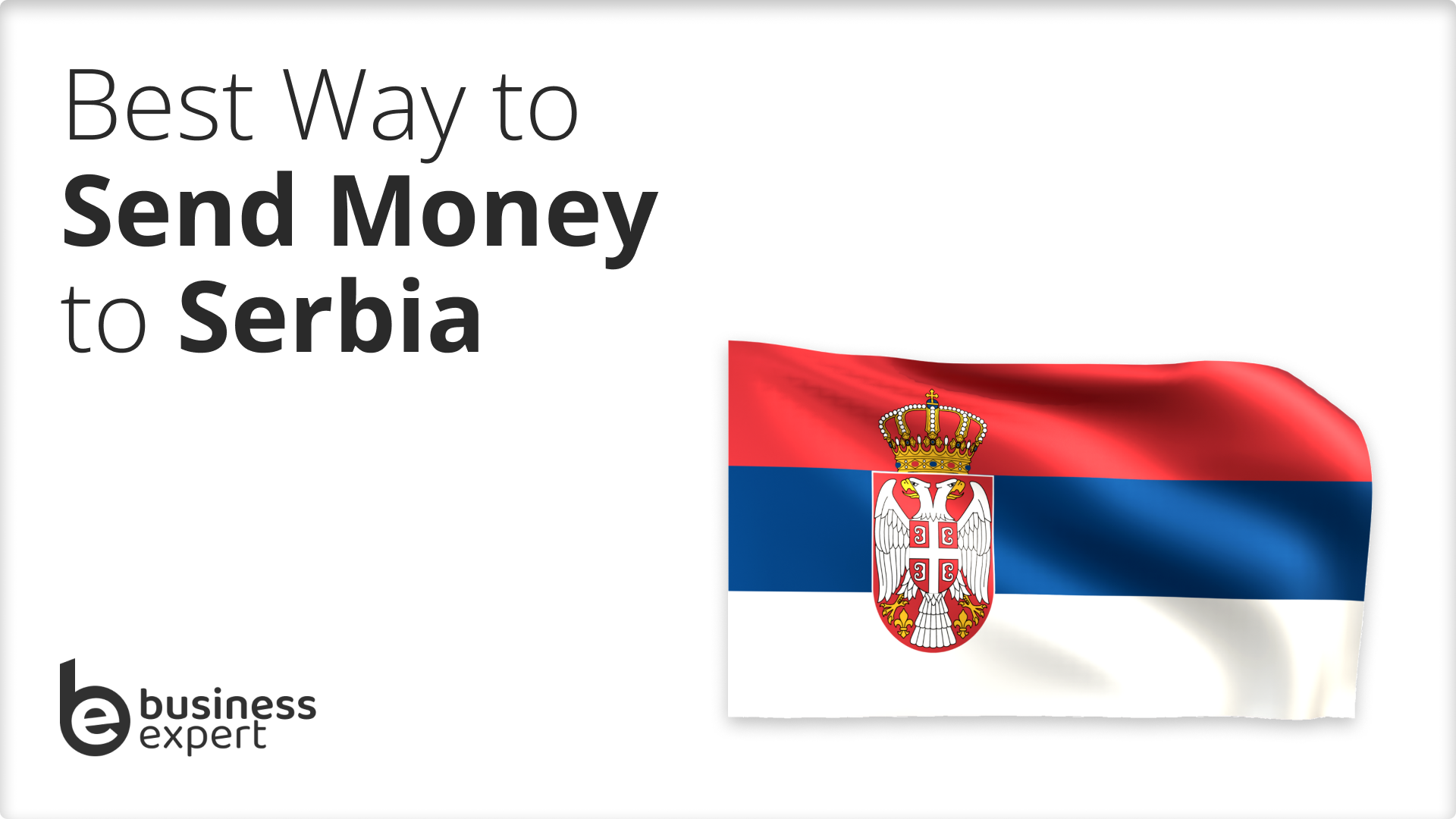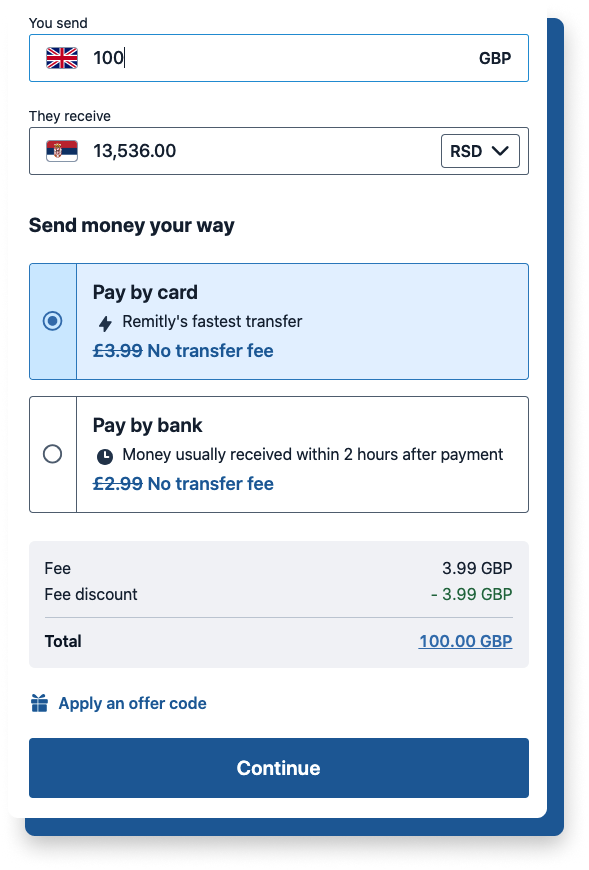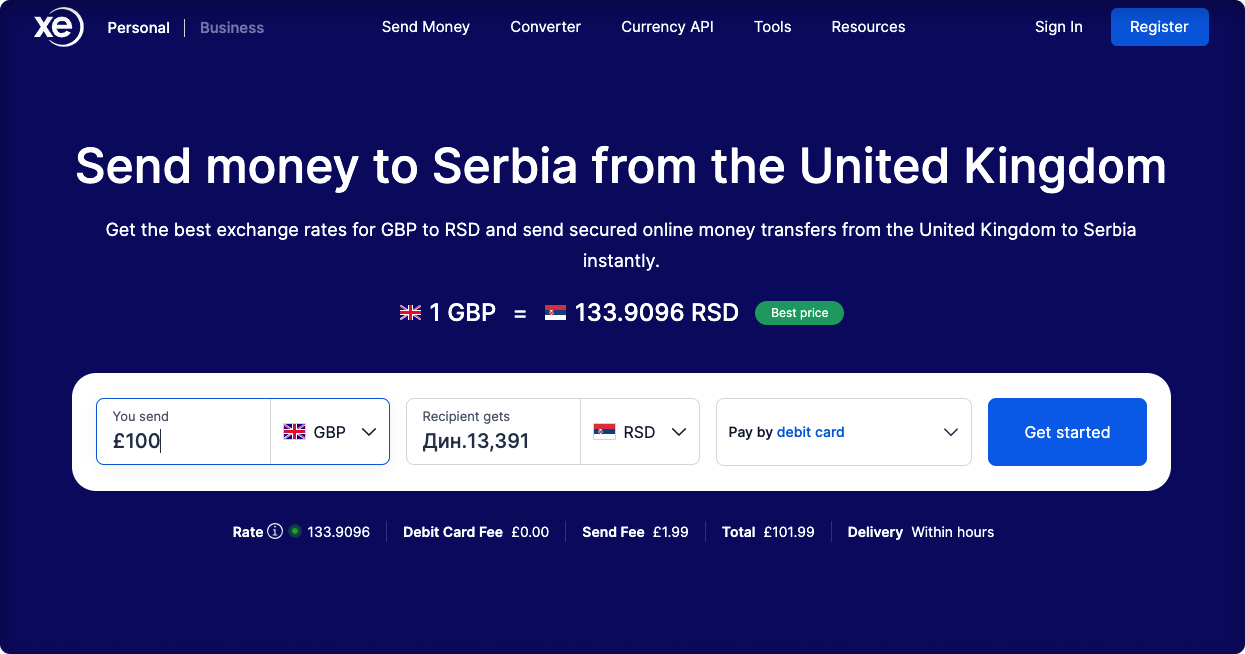You have several options if you need to send money from the UK to Serbia.
Whether sending money to family members or investing in a business, understanding the transfer fees, exchange rates, and regulatory requirements is essential.
In this article, I will explain the different transfer methods available so you can find the best way to send money from the UK to Serbia.

- What’s the Best Way to Send Money from the UK to Serbia?
- What’s the Cheapest Way to Send Money from the UK to Serbia?
- What’s the Fastest Way to Send Money from the UK to Serbia?
- Can I Send Money from the UK to Serbia Online?
- Sending Large Amounts of Money from the UK to Serbia
- Can I Set Up Regular Payments from the UK to Serbia?
- Sending Money from the UK to Businesses in Serbia
- How to Send Money from the UK to Serbia
- What Details Do I Need to Send Money from the UK to Serbia?
- How Much Does it Cost to Send Money from the UK to Serbia?
- How Long Does it Take to Send Money from the UK to Serbia?
- Frequently Asked Questions
What’s the Best Way to Send Money from the UK to Serbia?
The best way to send money from the UK to Serbia depends on your specific needs and preferences.
Online money transfer services like Remitly, MoneyGram and XE offer fast, cost-effective transfers with competitive exchange rates and lower transfer fees, getting more Serbian dinars for your pound.
However, some providers like Paysend have a low maximum transfer limit, which could be an issue for larger transfers.
In this situation, arranging a bank transfer to the recipient’s bank account in Serbia may be better.
Whilst reliable and secure, bank transfers are usually more expensive than online money transfer services and have longer processing times, typically between 2 to 5 working days.
What’s the Cheapest Way to Send Money from the UK to Serbia?
| Service | Transfer Fee (£100) | Exchange Rate (£100) | Transfer Fee (£2,000) | Exchange Rate (£2,000) | Learn More |
|---|---|---|---|---|---|
| Remitly | £0.00 (new customers), £2.99 for bank transfers or £3.99 card transfers | 135.36 | £0.00 (new customers), £2.99 for bank transfers or £3.99 card transfers | 135.36 | Visit Remitly |
| Western Union | £0 (new customer promotion) | 134.8001 | £0 (new customer promotion) | 134.8001 | Visit Western Union |
| MoneyGram | £0.00 (new customers) or £1.99 | 132.1534 | £0.00 (new customers) or £3.99 | 132.1534 | Visit MoneyGram |
| Paysend | £1.00 | 134.9865 | £1.00 | 134.9865 | Visit Paysend |
| XE | £1.99 | 133.9096 | £1.99 | 1333.9096 | Visit XE |
| Revolut | £10.00 | 136.14903 | £30.00 | 136.14875 | Visit Revolut |
Remitly is the cheapest way to send money from the UK to Serbia, offering a competitive exchange rate and free transfers for new customers.
Whilst Western Union and MoneyGram offer fee-free transfers for new customers, Remitly has a better exchange rate, getting you more RSD for your GBP.
Revolut offered the best exchange rate of 136.14903 at the time of writing. However, the transfer fees counteract any potential gain, so Remitly would still be the most cost-effective option for sending money from the UK to Serbia.

What’s the Fastest Way to Send Money from the UK to Serbia?
| Service | Transfer Speed | Learn More |
|---|---|---|
| Remitly | Within minutes by card or within 2 hours after payment by bank transfer | Visit Remitly |
| MoneyGram | Within minutes | Visit MoneyGram |
| Western Union | Within minutes | Visit Western Union |
| Paysend | Within minutes | Visit Paysend |
| XE | Within hours | Visit XE |
| Revolut | 1 business day | Visit Revolut |
Online money transfer services like Remitly are the fastest way to send money from the UK to Serbia.
Remitly, MoneyGram, Western Union and Paysend all offer quick transfers, with the recipient receiving funds in Serbia within minutes through standard transfers.
However, as you can see from the table, none of the providers I evaluated have long transfer processing times, with all providers sending money to Serbia within one business day.
Some online money transfer providers may also often expedite options to speed up your transfer further for an additional fee.

Can I Send Money from the UK to Serbia Online?
You can send money from the UK to Serbia online in several ways.
- Online Money Transfer Services: Companies like Remitly and Paysend offer fast transfers that the recipient can receive in Serbia in just minutes. Exchange rates are competitive, but some providers limit the money you can send, making them less suitable for large transfers.
- Bank Transfers: This method is best used to securely send large amounts of money to popular Serbian banks like Raiffeisen, UniCredit, and Erste. Although reliable, it has longer processing times for 2 to 5 business needs, so you’ll need time to wait for the funds to arrive in Serbia.
- Digital Wallets: Services like PayPal and Skrill are perfect for smaller, informal transfers to friends and family members using the same digital wallet service. While digital wallet transfers are fast, they often have high fees and low maximum transfer limits, making them less suitable for large transactions.
- Cash Pickup Services: Similar to an online money transfer service, but instead of an electronic transfer, the recipient collects funds in cash from designated pickup locations in Serbia. Transfers through providers like Western Union and Moneygram are fast but typically have high fees and lower maximum transfer limits.
- Prepaid Debit Cards: Services like Revolut offer preloaded cards you can top up online and send to the recipient for use at ATMs or merchants in Serbia. Suitable for recipients who don’t have a bank account, prepaid cards can have high fees for activation, reloading and withdrawals, making them less cost-effective.
- Cryptocurrency: You can use digital currencies like Bitcoin or Ethereum to transfer value directly to the recipient in Serbia. While cryptocurrency transfers have potentially lower fees than traditional methods, the value volatility means the recipient may receive less than intended.
Sending Large Amounts of Money from the UK to Serbia
| Service | Maximum Transfer Limit | Learn More |
|---|---|---|
| Revolut | There is no specific limit which varies between accounts. Shown in the app before requesting the transfer | Visit Revolut |
| XE | £350,000 per transfer | Visit XE |
| MoneyGram | £40,000 per transfer | Visit MoneyGram |
| Remitly | Tiered limits that vary between accounts. 24-hour: £5,000 – £25,000, 30-day: £15,000 – £25,000, 180-day: £50,000 – £150,000 | Visit Remitly |
| Western Union | £8,000 per transfer | Visit Western Union |
| Paysend | US$1000 (approx £790) per transfer, and $15,000 (approx £11,877) in 3 months | Visit Paysend |
Revolut is the best way to send large amounts of money from the UK to Serbia, offering no maximum transfer limit for most accounts.
XE is also a great choice, allowing you to send up to £350,000 per transfer.
It’s essential to compare the exchange rate and fees charged by different service providers to maximise the value of your transfer.
Some providers may offer discounted transfer fees and enhanced exchange rates, while others, like Revolut, scale their fees based on the amount you send.
Be aware of potential tax implications in the UK and Serbia for transferring large amounts of money. Consult with a financial advisor or tax expert to understand any tax obligations.
Opt for secure transfer methods with encryption and other security measures to safeguard your funds during the transaction process.
You should also enquire about insurance coverage or protection offered by the service provider for large transfers to safeguard against potential risks such as fraud or loss during the transfer process.
Depending on how much you want to send to Serbia, your provider may ask for further details or documents to comply with relevant regulations and legal requirements governing international money transfers, including anti-money laundering (AML) and know-your-customer (KYC) regulations. These documents could include copies of valid government-issued IDs, source of funds and proof of address.
Can I Set Up Regular Payments from the UK to Serbia?
You can set up regular payments from the UK to Serbia in several ways.
- Online Money Transfer Services: Providers like Remitly and XE offer convenient and flexible recurring payment options with competitive rates. Whilst most providers can accommodate large transfers, some may limit the amount you can send within a specific time frame, which could be an issue for large, regular payments.
- Standing Orders: You can set up a standing order with your UK bank, allowing them to transfer regular payments to a Serbian bank account automatically. While this method is convenient, it’s only suitable for fixed payments, as you’ll have to set up a new standing order if you want to make any changes.
- Direct Debits: Typically used for services and subscriptions, direct debits are similar to a standing order, but the recipient in Serbia initiates the payment request. Direct debits are more flexible than standing orders, but you won’t have control over payment timings or amounts.
- Digital Wallets: Services like PayPal allow you to store funds and make payments electronically to recipients in Serbia who also have digital wallets. They’re fast and convenient but have higher fees than other methods, making them less cost-effective.
- Cryptocurrency: This method is best for tech-savvy individuals who understand cryptocurrency processes. Cryptocurrency transfers are fast and may have lower fees but are less widely accepted than other methods.
Sending Money from the UK to Businesses in Serbia
Online money transfer services like Remitly and Revolut are usually the best way to send money from the UK to Serbian businesses.
These services have competitive exchange rates and low fees and are ideal for time-sensitive transfers, usually arriving within one business day. However, some providers may limit the amount of money you can send to Serbia, which could be an issue for larger transfers for business investments.
Alternatively, you can transfer money directly to the business’s bank account in Serbia through a bank transfer. Ideal for large, regular payments like invoices, bank transfers are secure and reliable but typically incur higher fees and slower processing times.
When sending money from the UK to businesses in Serbia, clearly communicate the purpose of the payment to the recipient business and ensure that it complies with any relevant regulations or legal requirements governing international transactions.
You may need to provide supporting documentation or invoices for verification and the business’s 9-digit Serbian Poreski Identifikacioni Broj (PIB) number.
How to Send Money from the UK to Serbia
Depending on your transfer provider, you may be able to fund your transfer to Serbia using several methods, including:
- Bank Transfer: This method is best for larger transfers with sufficient funds in your UK bank account. Although bank transfers are secure and reliable, they may have a longer processing time, delaying your recipient’s access to funds in Serbia.
- Credit Card: Transfers funded by credit cards have additional financial protection through regulations and a near-instantaneous processing time. However, this convenience typically incurs higher fees and interest rates than other methods.
- Debit Card: Due to daily spending limits, debit card payments are best suited to small and medium-sized transfers. They’re similar to credit card payments but usually have lower fees and less consumer protection.
- Cash: Suitable for those who don’t have a traditional bank account or prefer to make payments in person, transfers funded by cash are processed quickly but are less convenient and subject to cash handling limits.
Cheque: This method provides a paper trail for transactions and is suitable for larger transfers. However, cheque payments have long processing times and have limited acceptance compared to other methods
What Details Do I Need to Send Money from the UK to Serbia?
To send money from the UK to Serbia, you’ll typically need the following details:
- Recipient’s Contact Details: The full name of the person or business you’re sending money to as it appears on their bank account, as well as their address, phone number and e-mail address.
- Recipient’s Bank Details: This includes the bank name, address, account number, 22-character IBAN and 8-11-character SWIFT/BIC code.
- Tax Details: Depending on the amount you send to Serbia, you may be asked to provide the recipient’s Serbian tax identification number (TIN). For individuals, this is the 13-digit Serbian Unique Master Citizen Number (Jedinstveni Maticni Broj Gradana, or JMBG). For businesses, the TIN is a 9-digit Serbian PIB (Poreski Identifikacioni Broj).
- Further Documents: Some providers may request additional documents for verification checks or regulatory compliance. These documents could include copies of valid government-issued IDs like passports, proof of your address (like a utility bill), or proof of the source of your funds.
How Much Does it Cost to Send Money from the UK to Serbia?
For most people, the cost of sending money from the UK to Serbia is the first thing they consider.
Usually, online money transfer services like Remitly are cheaper and more cost-effective than bank transfers.
Some of the most common types of fees are:
Transfer Fees
Your service provider may charge a transfer fee to process the transaction.
The transfer fee can vary depending on the provider and the amount sent from the UK to Serbia.
You can expect to pay around £0 to £5 per transaction in transfer fees using online money transfer services or between £10 to £30 per transaction using a bank.
Exchange Rate Margin
When converting your money from British pounds to Serbian dinars, the service provider may offer you an exchange rate with a margin added to the real exchange rate. This margin is how they make money from the currency conversion.
Exchange rate margins typically range between 0.5% and 2% above the mid-market rate for online money transfer services or between 2% and 5% above the mid-market rate for banks.
Bank Charges
If you’re using a bank transfer, your bank may impose additional charges for international transfers.
These can include flat fees or a percentage of the transfer amount, ranging from £10 to £30 per transaction, depending on the bank and type of account.
Recipient Fees
Recipient fees refer to any charges the recipient may incur upon receiving the funds in Serbia.
Sometimes, the recipient’s bank may deduct a fee for processing incoming international transfers, especially if the funds are received in a foreign currency like GBP.
Additionally, if the recipient receives the funds in cash through a pickup location, there may be fees associated with collecting the money.
These fees vary depending on Serbia’s receiving bank or payment service provider but are usually around 1% to 3% of the transfer amount.
Additional Services
Some providers may have hidden fees, such as charges for expedited transfers or fees for using certain payment methods.
Express transfers from the UK to Serbia can cost between £5 and £50 per transfer, depending on the urgency of the transfer.
How Long Does it Take to Send Money from the UK to Serbia?
Online money transfer services like Remitly and MoneyGram are faster than traditional bank transfers for sending money from the UK to Serbia.
While the recipient can receive funds in Serbia in as little as minutes through an online money transfer service, bank transfers can take 2 to 5 business days.
Bank transfers to popular Serbian banks like Kormercijalna and OTP are longer due to more financial institutions being involved.
First, your bank in the UK processes the transfer, which can take a day or two. Then, the money travels through the international banking system to reach the recipient’s bank in Serbia. This part also takes a couple of days.
Other factors that can influence the speed of your transfer to Serbia include how you fund it, with bank transfers usually processed slower than those funded by card.
Some providers may require additional verification steps, which can prolong the processing time.
Transfers initiated outside regular business hours or on weekends may experience delays, as banks and financial institutions typically operate during business hours.
My Methodology
When researching and writing this article about how to send money from the UK to Serbia, I followed the process below:
- Research: I extensively researched using reputable sources such as financial institutions, money transfer service providers’ websites, industry publications, and government resources to provide accurate and up-to-date information on various methods and considerations for sending money from the UK to Serbia.
- Provider Selection: A wide variety of sources were selected based on their prominence, reliability, and suitability for international transfers between the UK and Serbia. These providers were chosen to offer users diverse options to consider when sending money, ensuring comprehensive coverage of available services.
- Comparison: Each selected provider was thoroughly evaluated and compared based on transfer fees, exchange rates, transfer limits, transfer speed, and user experience. This comparison aimed to provide users with valuable insights into the pros and cons of each service, enabling them to make informed decisions based on their specific needs and preferences.
- Updates: I aim to continuously update this article to ensure the accuracy and relevance of the information in this article. This involved monitoring changes in transfer fees, exchange rates, service offerings, and any updates to regulations or policies that could impact sending money from the UK to Serbia. Users are encouraged to verify the latest information directly from the providers’ websites or contact customer support for the most current details before making any decisions.
Frequently Asked Questions
Can I send money from the UK to Serbia?
Yes, you can send money from the UK to Serbia through various money transfer services such as Remitly and XE.
These services allow individuals to transfer funds electronically, typically through online platforms or mobile apps, enabling them to send money securely and efficiently to recipients in Serbia.
Can you send money to Serbia with PayPal?
You can’t send money to Serbia with PayPal directly, but you can use Xoom, a PayPal family member specialising in international money transfers.
However, it may be cheaper to use Remitly or MoneyGram as Xoom typically has higher fees and a less favourable exchange rate. You’ll also only be able to send money in euros through Xoom, as the Serbian dinar isn’t supported.
Can you send money to Serbia with Revolut?
Yes, you can send money to Serbia with Revolut. However, there may be more cost-effective options. Revolut offers a competitive exchange rate but also has transfer fees, which can be high depending on the amount you send.
Alternatives to Revolut include Remitly, Western Union and MoneyGram.
Can I send money to Serbia with Wise?
No, at the time of writing, you can’t send money to Serbia with Wise. However, you can use other online money transfer services like Revolut.
Can you send money by Western Union to Serbia?
Yes, you can send money by Western Union to Serbia through their cash pickup service or a bank transfer.
However, depending on how much you want to send, you may receive more dinars for your pound by using Remitly.
